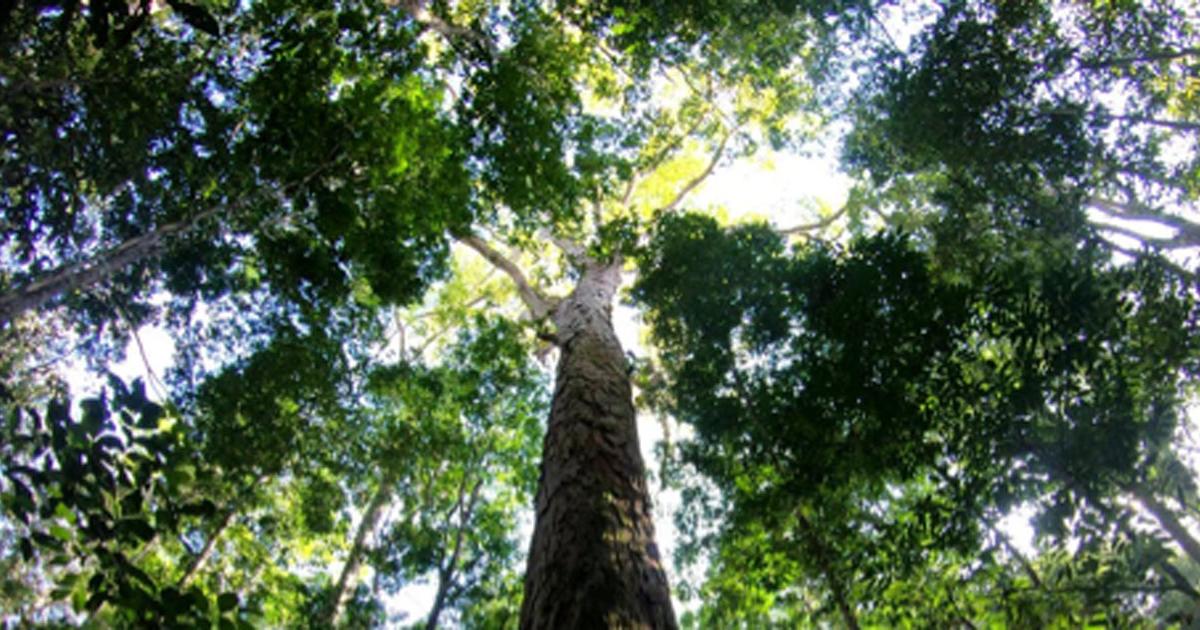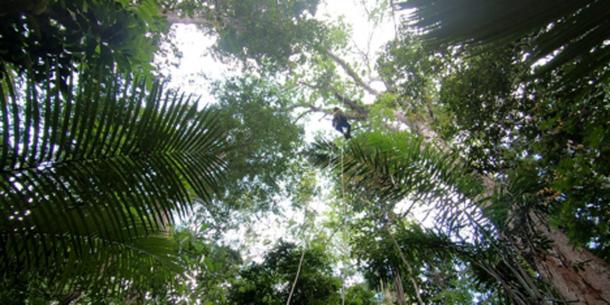
A 400-Year-Old ‘Carbon Colossus’ Heralds Hope for Amazonia
At a staggering 88 meters tall, a 400-year-old tree found in the Brazilian Amazon has been declared the region’s largest tree. Researchers are now trying to figure out how it grew to such heights.
The Conversation reports that the gigantic Amazonian tree is over 30 meters (98.43 ft.) taller than the previous tallest tree record holders. It’s located in the Guiana Shield of north-eastern Amazonia in Brazil and researchers Tobias Jackson and Sami Rifai explain it can “hold as much carbon as an average hectare of rainforest” making the discovery a point of interest for environmentalists worldwide. They published the results of their study in Frontiers in Ecology and the Environment.

The Amazon’s new record-breaking tree. (Tobias Jackson)
The tree is believed to be about 400 years old. It is a member of the Angelim vermelho ( Dinizia excelsa) species. This type of tree is common in the Amazon and has often been sought out for timber, but until now it was believed that the trees didn’t grow taller than 60 meters (196.85 ft.) in height.
- The Oldest Tree in Europe has been Discovered in Italy
- Woe of the Witches – The Elevated Flying Rowan Tree
- Firefighters in Arizona Make Dramatic Rescue of 1,000-Year-Old ‘Medusa Mother Tree’
At 88 meters, 288.71 ft. tall, the tree stands only about 6 meters (20 ft.) shorter than the Statue of Liberty, which measures 93 meters (305 ft.) including its base. The trunk has a diameter of 5.5 meters (18.04 ft.), according to BBC News.
The research team was led by Eric Gorgens and Diego Armando da Silva and included researchers from Brazil and Britain. Gorgens says that most trees in the Amazon only reach to about half the height of the large Angelim Vermelho.

Climbing an Amazonian tree. (Inverse)
A Carbon Colossus
This “carbon colossus” doesn’t stand alone. The researchers found at least 15 of the giant trees measuring over 70 meters (229.66 ft.) tall. They were tipped off to the existence of the huge trees not by strolling through the rainforest (actually they describe the journey as a rather impressive hike!), but by using aerial laser scanning (LiDAR) with the help of the Instituto Nacional de Investigaciones Espaciales de Brasil (INPE).
Most of the larger trees were identified in areas around the Jari river, a tributary of the Amazon. Jackson and Rifai have explained what this massive discovery means for the environment:
“our research suggests that the north-east of the Amazon could store far more carbon than previously thought. Each Angelim vermelho can store as many as 40 tonnes of carbon – that’s between 300 and 500 smaller trees, while occupying the space of only 20. And although we only visited 15 trees, this was a small proportion of the trees the laser scanning data revealed, which was itself covered only a tiny proportion of the Guiana Shield. So, there are likely to be many more giant trees out there – and some may be even taller than our record-breaker.”
They also touch on other aspects of the discovery’s significance in their paper:
“Large trees are particularly important as a source of inspiration to the general public, often playing a key role in campaigns to conserve forests. Furthermore, their dynamics are important for the maintenance of plant and animal diversity, and they contribute disproportionately to biomass and productivity.”
- How Credible Are the Superstitions Surrounding the Mystical Irish Fairy Trees?
- Fancy Sipping a Pint in a 1700-Year-Old Tree? You Can at The Baobab Tree Bar
- A Symbol of Peace, Victory, and Abundance: The Millennia-Old History of the Olive Tree

Tree top of a Dinizia excelsa. (CINBESA)
How Did the Tallest Tree Grow to Such Heights?
The research team is now wondering how the tallest tree and its companions grew to tower over the others in the area. Jackson and Rifai offer the following suggestion:
“As pioneer species – the first to grow into any new areas or gaps in vegetation – it’s possible that they took advantage of some past disturbance that cleared part of the forest, perhaps caused by a storm or by human habitation. The fact that they have survived so long and grown so tall must be at least in part thanks to their sheer remoteness from urban areas and industry.”
They will use soil, leaf, trunk, and other samples alongside other data obtained on the trek into the forest to try to solve this puzzle.

A Dinizia excelsa tree. (CINBESA)
The trees are located in a protected space called Paru State Forest that is larger in area than Belgium. They are in a space that is still safe from the Amazonian forest fires and believed to be safe from human interference as well, as Jackson says, “It took us five days to get there by river, so I don’t think it would be economically feasible to start logging there.”
Top Image: The Amazon’s new record-breaking tree. Source: Tobias Jackson















